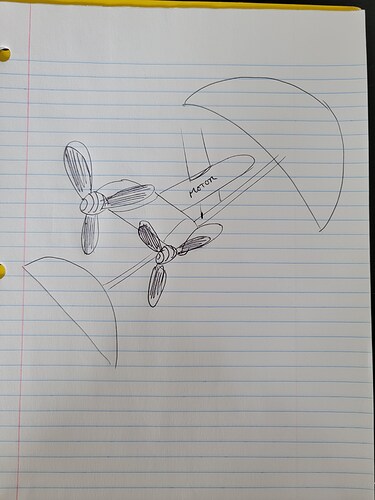They look like they are. Does anyone have thoughts on two props rotating side by side? I saw something like that on a forum here yesterday, I could find it with some digging. But would that lower the force on each one by 50% or do the forces not increase linearly?
What do you mean? Just draw it in pencil on paper and take a picture.
Or casted in aluminium using @jeffM method, a 3D printer can print in lost wax too which gives a very nice finish.
Im thinking of two props arranged side by side like the rotors on a chinook helicopter, apologies in advance for the terrible drawing. Would it benefit in any way, or would the extra losses in drag on a second prop and from the gearbox assembly take away too much to make it worthwhile?
Plus the colossal drag if a much larger shroud was to be installed…
.
There wouldn’t be much benefit unless you wanted to downsize the motors and props. I designed a similar system to utilize 2 jets off one motor but there’s no real point as its just increased drag at the end of the day…
I guessed as much. In a similar vein, what if the motor shaft protruded from both ends and a prop could be fixed to the front also?
I only have access to a 3D printer so it would be great to have blades that dont break, without getting too invested in carbon fibre molding or alu casting.
Like so:
I notice I’m going off topic. let me do some research and I’ll start a new thread if i think its plausible. Thanks!
Its already been tried on the forum and had no advantage unless you wanted to use smaller motors…
Ah ok. Good to know. Thanks.
If it was beneficial, it would have been promoted, tested, optimized, etc. here on the forum for several years. I think the main drawbacks are as follows:
- reduction in drive efficiency by about 30% (drive efficiency is the most important parameter for all e-drives)
- significant increase in system failure rate
- higher acquisition costs
What was the failure mode of these PLA+ folding props, a photo would be interesting to see?
I wonder if polycarbonate would make for a stronger prop, if you could get it to print with enough detail, or sand it smooth.
The flexidrive folding propellors have a bumper to soften the shock of the blades opening up.
Problems I always had with any 3D printed prop is it just vibrating itself apart. Such a pain to get it balanced. I wish someone would just make a motor with the same shaft as Lift motor or someone would make a strong folding prop for the 65161 motors. I’ve tried making my own 3D folding prop designs but they never hold up for more than a handful of sessions. I should ask a machine shop for a quote.
Which filament were you using?
PETG prusament. 100% infill for blades and 70% for hub
Which part broke whilst vibrating to bits?
It seems that PETG is strong but brittle, and may not be the best filament for the impact of a folding prop banging open.
Polycarbonate might be more shock resistant and stronger.
ASA could be more suitable for post-processing, sanding, gluing extra weight, which is difficult with pla and petg.
The lift folding prop is expensive, and not feasible for a cheap foil drive build. Balancing props looks time consuming, likely more so with a folding prop, and one that mounts to 4 bolts onto an outrunner.
That makes a lot of sense. I think in the coming weeks I’ll still look into machining an aluminum option. It’s definitely going to be expensive but that’ll be worth it if I can finally ride swell unpowered.
There are some outfits in NZ where you can get your prototyping parts laser sintered in Nylon 12.
https://www.callaghaninnovation.govt.nz/addlab/our-printers
Quality is impressive and material is super tough. Although not sure if a bit of flex is OK for the blades, or if you need the stiffest material possible.
Interesting idea of using nylon.
3d printed CF-reinforced nylon filament seems like it might be worth a try. Nylon seems to have much higher impact toughness than ASA or PLA, as it is flexible. The carbon fibres reinforcement make it easier to print without warping, and provides more stiffness and strength. However, it is twice the price of PLA/ASA. I don’t think a bit of flex would be an issue for a foil assist, as the power level is low.
Not 100% sure but think some of the smaller outboard propellers are some type of black nylon mixed with glass fiber reinforcement. Ordinary glass is probably better than carbon in this application, carbon is too stiff to work well together with nylon.

